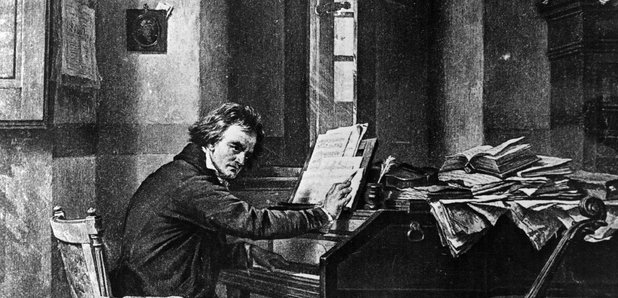|
||
|
Beethoven's fifth symphony was composed over the remarkably long period of four years. The earliest sketches date from 1804, shortly after the completion of the Eroica symphony, but Beethoven kept putting the work aside in favour of other compositions, including the fourth symphony, the fourth piano concerto, the Razumovsky string quartets and the violin concerto. During 1807 and 1808 he was working on both the fifth and sixth symphonies. It was premièred at an all Beethoven concert, directed by the composer on the 22 December 1808 at the Theater an der Wien. The concert was over four hours long, and contained an amazing number of new masterpieces.
Like most of Beethoven's works the fifth symphony follows the established classical conventions of Haydn and Mozart but with many radical innovations. Important among these was the introduction of three trombones, a piccolo and a contrabassoom to the symphony orchestra. However, what really distinguishes Beethoven from his predecessors is the overall unity he brings to the work through the use of motivic development. The fifth symphony is given its cohesion by the very famous four note motif that opens the work - allegedly described by Beethoven as fate knocking at the door. This is heard brazenly in the first and third movements, but is also present in the second and last movements and is the seed from which some of the other melodic material is grown. The first movement is a remarkable example of economy in musical composition. Throughout it the opening four note motif is hardly ever absent appearing in a variety of slightly varied forms. When the second subject is introduced the motif takes on the role of accompaniment. The closing subject offers a short break, but only for 16 bars before the motif returns to close the exposition. From start to finish the movement is filled with a dark brooding energy with one notable point of respite being a beautiful cadenza for the oboe which Grove described as "a flower of gentian spreading its petals on the edge of the glacier". The second movement is a set of variations on a theme with a confident march like character in Ab major played first by the lower strings, then elaborated by the woodwinds in passages of greater uncertainty and chromatic movement. One of the most remarkable features of the movement is that in two of the variations Beethoven modulates his thematic material from Ab major to the key of C major and adds trumpets and drums giving it the character of a military march. This modulation anticipates the final movement of the symphony contributing to the structural cohesion of the work. The third movement returns to C minor with a scherzo that starts with a playful arpeggio figure announced by the cellos, after which follows a stormy passage based on the opening motif of the symphony. The contrasting trio is highly contrapuntal virtuosic music. The remarkable feature of the movement is that the return of the scherzo has a totally different character to its original statement. The orchestra plays very quietly and uncertainly with pizzicato strings and soto voce woodwinds finally coming to rest on a Ab pedal note which begins the transition to the finale. There is a gradual crescendo in which the harmony modulates from Ab to C, echoing the second movement, but this time arriving in a blaze of colour provided by the whole orchestra and strengthened by the first appearance of three trombones in any symphony. The theme is a grand military march in the French style full of joy and triumph. However, the journey from darkness to light is not quite over. Amid the jubilation Beethoven surprisingly reintroduces the musical idea of the transition from the third to fourth movement, but this second time the triumphal march persists to the end of the work. Beethoven's fifth Symophony was performed by the Portobello orchestra on the 23rd November 2013, conducted by Matthew Rogers. back |

